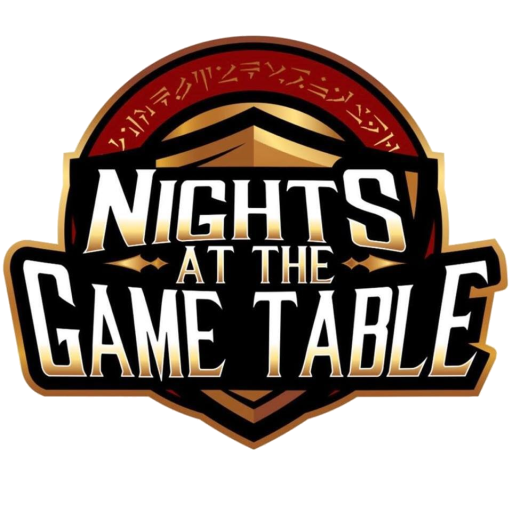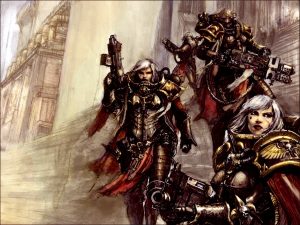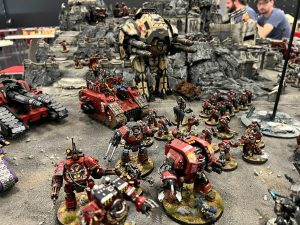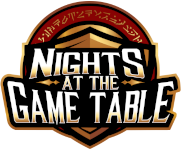Warhammer Tactics is back, and it’s coming in with a double feature. Today, we’re going to be looking at the ideas of being “Casual” and “Competitive” are, both from the perspective of players and models in the game.
There’s often a lot of miscommunication when it comes to these ideas when it comes to talking about people, and we’re going to put an end to that by changing up the way we think about these issues. Without further ado, let’s dive in!
First, we need to do away with a common misconception that many players have when it comes to being casual or competitive.
Frequently people think of this as a dichotomy, or a situation with two possible options.

In truth, being competitive or casual is more of a scale than a binary situation. When we really slow down and think about this, it becomes apparent that even very casual players have at least some competitive elements, and vice versa.
After all, even the most laid back and story-driven of players are still trying to defeat their opponent, which by nature makes them at least somewhat competitive.
By the same token, even the most competitive of players are still having at least some fun. Even the Nick Nanavati’s of the world are enjoying what they do. They simply enjoy the strategic elements far more than the story driven elements, but they’re still having fun. We know this is the case because generally, competitive 40K isn’t a viable way to make a living, which leaves fun as the only realistic option.
So, if casual players are at least partially competitive and competitive players are still having fun, what does this mean? Well, it means we need to rethink the terms that we use when we talk about 40K players, and how we use them.
The terms themselves are fine, but the meanings behind them need to be looked at. When people think of “casual”, they usually think of the guy that has a theme force or just loves the lore. This isn’t 100% a correct definition, as some competitive players also have a themed army or avidly follow the deep universe that Games Workshop has crafted for Warhammer 40K. Instead, we should view “casual” as one end of a scale, with that end of the scale representing the desire to play 40K in a way that’s accurate to the actual universe.
 In other words, they aren’t looking at playing a mathematically optimized list so much as they want their army of Space Marines to accurately reflect what a typical Space Marine force should look like. Keep in mind that this is an extreme example, since it’s describing the far end of a scale. A more mundane example of this kind of player is the person who just buys models that they think look cool on the table, or could even be loosely based on actual force compositions from the 40K lore.
In other words, they aren’t looking at playing a mathematically optimized list so much as they want their army of Space Marines to accurately reflect what a typical Space Marine force should look like. Keep in mind that this is an extreme example, since it’s describing the far end of a scale. A more mundane example of this kind of player is the person who just buys models that they think look cool on the table, or could even be loosely based on actual force compositions from the 40K lore.
This leaves us with the “competitive” end of our scale. When most people think of a “competitive” player, they typically think of someone that plays lots of tournaments or someone that spends their time trying to mathematically optimize their armylist in some way.

This is also not quite the right definition, as there are players that like to play in tournaments or optimize their lists while also adhering to strict rules based around their favorite army. Instead, we should think of a “competitive” player as someone who’s concerned about making their list as mathematically efficient as possible. In other words, they’re trying to make the best list possible under the game system of Warhammer 40K. This gives us a scale where all players will neatly fit on at any given time.
One of the beautiful things about thinking about the “casual/competitive” relationship this way is that it allows for a player to be in multiple places at the same time. Instead of it being an either/or scenario, we now liberate a player to place themselves where they want to be depending on the situation.

For their local games, they can be playing a more laid back and thematic force for their favorite faction, and then they can head off to an event with their Ynnari/Aeldari soup. This freedom of movement also has another important effect, which is removing the rather antagonistic “Us versus Them” mentality that unfortunately rears its head during these conversations and when interacting with one another.
At this point, we also need to address the elephant in the room. You’ll notice that Win At All Cost(WAAC) players haven’t been addressed, and this is for good reason.
WAAC players will generally placed on the far side of the “Competitive” spectrum that we have built, and even in general WAAC and competitive are sometimes used synonymously. This could not be further from the truth. WAAC players are players that break the social contract that two players agree upon when they sit down to play a game to help them win the game. This could be something as simple as taking a list that would be far more competitive and using it in a casual game, or as malicious as cheating and lying about dice rolls or abilities.
These players should not be thought of as competitive in any sense of the word. Although their lists are competitive, the WAAC player uses a competitive list as simply a means to an end (an easy victory), whereas a competitive player is seeking to optimize their list and gameplay to further their skills. In fact, most competitive players actually have issues with WAAC players as well. They can be bad for the community, and in extreme cases cause issues at events if they’re cheating.
Hopefully, these arguments have you re-thinking the way that you approach the concepts of being casual vs competitive, and ideally how you might refer to them. Most importantly though, it’s important to not demonize one another over discussions of how casual or competitive someone is.

We’re all playing Warhammer 40K, and there’s nothing intrinsically right (or wrong) about playing with a themed force based on the 10th company of the Ultramarines, or playing a list meant to go undefeated at Adepticon. In fact, we shouldn’t even strive to demonize all WAAC players. The most extreme of them are people who cheat, which should never be tolerated.
However, if you simply see someone playing an extremely competitive list against someone who’s just starting out or simply playing a more casual game, don’t be afraid to address that, politely. The more people that play 40K, the better 40K is for all of it’s players. This means that, at nothing else, stopping a negative player experience for a new player can be the difference between another new player at your store or not. But beyond this, it also affects how other people think of your local store.
With this out of the way, it’s time to shift gears and look at what makes a unit competitive, or not. Warhammer 40k has hundreds of different units, and yet only a small handful of them are considered competitive. The obvious question here is, why? Broadly speaking, there are two reasons to consider a unit competitive. By some metric, it’s extremely points efficient, or alternatively, it’s a very powerful support or synergy piece. These definitions are very vague on purpose, since units don’t exist in a bubble. Sometimes, units become highly competitive only when taken alongside a powerful support/synergy piece. In addition, “by some metric” is also vague, as the metric that a unit is efficient by depends on the metric we want to run with.
For example, consider an imaginary unit that has a 1 in every stat, including movement, no abilities, and a 7+ save. At first glance, this unit seems horrible. However, if it were a Troop choice and it only cost 1 point per model, we would have an extremely competitive unit. We can easily fill up Troop slots practically for free which in turn gives us lots of free CP, we can cheaply hold backfield objectives, and we have great speedbumps to protect a gunline. This is before we even consider any psychic powers, stratagems, or other support pieces that we have at our disposal.
The same kind of reasoning can be applied to support pieces. To take a real example, let’s look at Guilliman.

At 400 points, Guilliman is a reasonably powerful model when it comes to his stats on the table, but he’s definitely not 400 points. However, his ability to make Ultramarines re-roll all missed hits and wounds is a tremendously impactful ability that drastically improves the efficiency of all of our other units. This is to say nothing of the other abilities that Gman brings, of course.
So far, we’ve only really looked at these ideas from a unit perspective, and this is definitely an important perspective to consider when we talk about something as being competitive. However, we also need to consider army lists on a whole by these same metrics. For example, let’s look at a hypothetical list made out of a Castellan, some Catachans, and some Shield Captains.
 Our Shield Captains and Castellan are simply extremely powerful models compared to the points that we spend on them. A single Knight is a reasonably resilient model that packs an ungodly amount of firepower, while Shield Captains are highly mobile and well rounded units that can perform a variety of roles on the table. Meanwhile, our Catachans rely on a combination of powerful stratagems, traits, and auras to become significantly more efficient than they are on their own. These components come together to create a potent army list that has strong synergies and simply high amounts of point efficiency across the board.
Our Shield Captains and Castellan are simply extremely powerful models compared to the points that we spend on them. A single Knight is a reasonably resilient model that packs an ungodly amount of firepower, while Shield Captains are highly mobile and well rounded units that can perform a variety of roles on the table. Meanwhile, our Catachans rely on a combination of powerful stratagems, traits, and auras to become significantly more efficient than they are on their own. These components come together to create a potent army list that has strong synergies and simply high amounts of point efficiency across the board.
So, when you’re looking at a unit and considering if it’s worth running in your army, you need to consider not only how strong it is on it’s own, but also how it’s potential synergies and how it plays into the rest of your list. Often, units that are competitive are competitive for multiple reasons, some of which can be unclear at first glance. When contemplating the competitiveness of a unit, make sure you take the proper time to consider how the unit is efficient and what support pieces are available for it.
That wraps us up for today. We took a pretty analytical look at some of the theorycrafting behind why a unit might be considered competitive, and did a deep dive on how we talk about players versus how we should talk about players. Next time on Warhammer Tactics, we’ll be looking at Target Priority, what it is, and why it matters!




